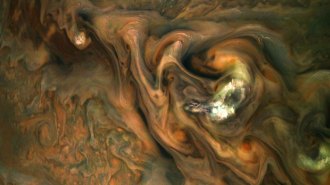Search Results
Science in a snap
Students will answer questions about the online Science News article “New high-speed video reveals the physics of a finger snap,” which details scientists’ exploration of the friction required for finger snapping. A version of the article, “Camera captures physics in a snap,” appears in the December 18, 2021 & January 1, 2022 issue of Science News.
Science on screen
Students will discuss the physics of finger snapping and apply their scientific knowledge to think critically about the scientific accuracy of movies and online demonstrations.
Reimagining plastics recycling
Students will evaluate experimental methods for recycling plastics, gather data about the types of plastics they use at home, research plastics recycling in their community and write a letter to local officials that advocates for improving plastics recycling.

Physics Helps Alien Rain Stay In Shape
In this guide, students will learn how the laws of physics shape rain on other planets and explore how molecules interact within alien raindrops.
Modeling molecules in alien rain
Students will compare and contrast rain on Earth with rain on other planets and practice drawing molecular structures of various rain substances to examine the substances' physical and chemical properties. Students will use that information, along with the planetary conditions needed to form rain, to create a short weather forecast for one planet.
Sizing up alien rain
Students will answer questions about the online Science News article “How the laws of physics constrain the size of alien raindrops,” which explores a new model for rain on planets across the Milky Way. A version of the story, “Physics helps alien rain stay in shape,” appears in the May 8, 2021 & May 22, 2021 issue of Science News.
Building better boxes based on beetles
In this activity, students will learn about the seemingly indestructible diabolical ironclad beetle and review Newton’s laws of motion and force diagrams. Then, students will design, build and test crush-resistant packaging using biomimetics, the practice of solving problems using solutions inspired by biological structures and systems.
Bonds in limbo
Students will answer questions about the online Science News article “This weird chemical bond acts like a mash-up of hydrogen and covalent bonds,” which explores new research that suggests chemical bonds exist on a continuum. A version of the story, “Chemical bond acts like a mash-up,” can be found in the January 30, 2021 issue of Science News.
Accepting the exceptions
Students will discuss the classical definitions of chemical bonds and determine how to adjust those definitions based on new research. Then, students will talk about the best strategies for assessing general chemistry concepts and exceptions to those generalizations.
The joy of science
Students will answer questions about the online Science News article “From Elvis worms to the Milky Way’s edge, these science stories sparked joy in 2020,” which summarizes Science News stories from 2020 that provided a happy distraction from the world’s worries. A version of the story, “Stories that sparked joy,” can be found in the December 19, 2020 & January 2, 2021 issue of Science News.
Protective headgear design challenge
Concussions are a common sports injury. After reviewing Newton’s laws of motion, force diagrams, momentum, and elastic and inelastic collisions, students will test various materials that might protect the head from sports collisions and use those materials to design protective headgear.
Exploring electromagnetic radiation
Students will watch a NASA video about the electromagnetic spectrum to learn about properties of the various types of radiation. Then, students will explore and discuss technologies that use specific types of electromagnetic radiation.